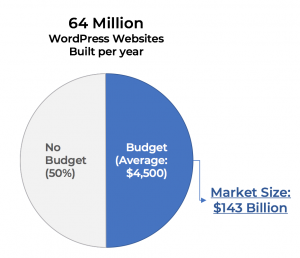As WordPress keeps on growing, so is the demand for WordPress themes. So, it’s no wonder that more and more web developers are turning into WordPress developers to tackle this niche, which can be very profitable.
If you’re one of them and have created your first WordPress theme, one of the things you’re probably wondering about is: “Should I sell my WordPress theme on a marketplace?”.
Well, that’s what this post is about – answering that very question by checking out the pros and cons of selling your WordPress theme on a marketplace.
Pros of Selling Your WordPress Theme on a Marketplace
There are several marketplaces where you can sell your WordPress theme. Some are big, some are small, some only allow one-time payments, others allow you to earn recurring revenue, and so on.
From what I’ve seen over the years, WordPress developers seem to prefer this method instead of creating their own online shop.
Let’s see if you like the idea after reading these pros.
Traffic
Marketplaces, especially famous ones, get a lot of traffic. This means that you can get exposure for your WordPress theme even from day one.
You don’t have to worry about learning and implementing ways to drive traffic yourself to your website and product.
Payment system
Marketplaces already have diverse and secure payment systems integrated into their platform.
You don’t have to worry about applying for an account to a payment processor, then implementing their system, then testing it with a sandbox, and so on.
You also don’t have to worry about generating invoices.
Ads
Most marketplaces buy ads for the WordPress themes found on their platform.
Your theme can end up in one of those ads, especially if it starts selling well, which means to them that it has the potential to generate more revenue.
So, you don’t have to take money out of your pocket, and you also don’t have to start learning complex ad platforms, such as Google Ads.
Marketing
Good marketing is crucial! It means nothing having a good product if you don’t know how to get it out there and promote it properly. I know this firsthand from my own failed projects due to the lack of good marketing.
And let’s face it, most web developers (talking about back-end here) don’t have marketing, UX and web design in their blood. You can spot a website made solely by a web developer from a mile. Some still use that 90’s design.
That’s why most WordPress developers work with web designers on their project, because no one would buy a WordPress theme that doesn’t have good looks and UX.
Marketplaces have dedicated marketing teams with web designers, UX experts, and the whole shebang. It’s hard to beat that. Thus, they are better at converting visitors into customers.
Of course, your WordPress theme has to be good enough to persuade potential buyers as well. But at least the first step, which is getting visitors to check your theme, is handled by the marketplace.
If you’d do this on your own, you’ll not only have to focus on the following things but also be good at them in order to convert:
- Web design;
- UX design;
- Conversion-centered design;
- Buying ads;
- Social media;
- SEO;
- Blog posts/Press releases for exposure and trust.
Website maintenance
As a web developer, you probably know that “set and forget” doesn’t apply to websites, especially if you create one with a CMS like WordPress. There’s always something that can break or be improved.
Since marketplaces handle their own platform, you won’t have to worry about things such as:
- Is your site is still up, or the server went to sleep?
- Is your site fast enough?
- Is your payment system still working, or weird errors started appearing out of nowhere?
- Is the sign-up form still working?
- Are emails still being sent?
- Is your site still looking good, or the CSS got messed up after the last minification?
- Is everything on your WordPress site still functioning after the last update?
Customer support
Since payments are handled by the marketplace, potential issues are being taken care of by their customer support. You don’t have to deal with questions and problems regarding payments, such as:
- Credit card rejection;
- Refunds;
- Disputes;
- Chargebacks.
Cons of Selling Your WordPress Theme on a Marketplace
After you’ve seen the pros, you might go “Wow, that’s amazing! Where do I sign up?”.
While there are a lot of advantages, you should also weigh in the cons of selling a WordPress theme on a marketplace.
These cons are general. Some of them might not apply to every platform.
A lot of competition
There’s competition in every type of marketplace, but it’s particularly crowded when it comes to WordPress.
Depending on the platform that you choose, your WordPress theme can get lost in tens of thousands of other themes.
So, even if the marketplace gets a ton of traffic, it will be significantly split. Some sellers complain that well-established WordPress themes with big sales are still the ones that get more exposure and sells.
Therefore, you’ll still need to make an effort to promote your WordPress theme wherever you can, such as social media, blogs, etc. Your success chances are low if you just plan on submitting the theme and waiting. It’s not like fishing. 🙂
Lack of complete control over pricing
Different marketplaces have different pricing rules that you need to follow. You could be forced to start at a certain amount and not go over a certain amount.
For example, maybe you want to sell your WordPress theme at $199, but the marketplace doesn’t allow a price higher than $59.
Their cut can be pretty big
Obviously, the marketplace takes a cut every time you sell your WordPress theme. That cut can differ depending on several factors:
- The marketplace you choose;
- If you’re selling exclusively on their platform or not;
- The number of sells you produce. Usually, the more you sell, the lower the fee gets.
For example, if you’re selling exclusively on their platform, the general fee can be up to 30%. Depending on the marketplace, it can be lower if you sell more.
If you’re not selling exclusively, the fee can grow up to 50% or more.
Withdrawal limit
Some marketplaces won’t allow you to withdraw your money if you haven’t reached a certain threshold. For example, you can’t withdraw your earnings until you reach $100.
High rejection rate
Some marketplaces have very strict coding standards, which is good. But this means your WordPress theme will probably get rejected a lot, especially if you’re a beginner to WordPress development.
And the bigger the marketplace, the bigger the waiting time.
For example, on Envato, it can take weeks of waiting just to see that your WordPress theme got rejected. And you have to tweak it, resubmit it for revision, and wait again. And time means money, right?
No control over unfair and irrational reviews
Virtually all marketplaces use a star rating system, which I personally hate because most customers don’t know how to use them properly, as you can read from my rant on Fiverr ratings.
So, you’ll end up very often with a crappy rating, such as:
- “This theme is awesome!!!” – leaves a 3-star rating; 😡
- “I couldn’t install the theme” – leaves a 1-star rating. 😡

And the problem is that ratings matter a lot for buyers. If you get some crappy ratings in the beginning, it can mean the death of your WordPress theme right from the start.
Marketplaces Where You Can Sell Your WordPress Themes
I’ll point out the main marketplaces that I know, where you can sell your WordPress theme. If you know more, feel free to leave a comment.
- ReadyShip – A Saas platform that allows you to earn recurring revenue without fees. More details below.
- Themeforest (part of Envato) – The biggest WordPress marketplace for themes, but the competition is extremely high, and the recent changes made some sellers upset. So, the next 3 marketplaces can be good Themeforest alternatives for selling your WordPress theme.
- Templatemonster – They like the themes to have a certain design, mainly flashy, trendy, and conversion-centered. I know this because I submitted a minimal Bootstrap theme, not WordPress, and got nuked because the design didn’t match their standards.
- MojoMarketplace – Tread carefully because it kind of looks abandoned. 🙂 At least that’s the feeling I get browsing their site.
- Creative Market – It’s not really a brand that pops up when people think of WordPress themes. It’s not, like, a go-to place. So, the number of people that come there specifically for WordPress themes can be low-ish.
ReadyShip – A different type of marketplace

I said that I’ll offer you more details about ReadyShip, so I deliver. 🙂 I’m also a seller, so I know what’s going on under the hood.
ReadyShip is a Saas (Software as a Service) WordPress marketplace, where WordPress developers can sell their themes and earn recurring revenue, not just one-time payments.
I also mentioned that ReadyShip doesn’t take a fee on the price that you set. That’s because their profit comes from the managed AWS hosting that they offer along with your product.
Therefore, whatever you add on top, is yours!
Hosting…?
Yes, ReadyShip is a different kind of animal. 😀
When a customer buys your theme, which you set up on the WordPress environment provided by the platform, she/he also gets managed AWS hosting with that.
You can also add plugins to the setup, which I strongly recommend, that will work well with your theme and niche demo. That way, the customer ends up with an all-in-one solution, a ready-made WordPress website or blog. This is what ReadyShip is ultimately about.
This will also offer you a more controlled environment because:
- You can add the plugins that you think are best and work well with your WordPress theme. Thus, preventing the user to add whatever plugins they find, potentially breaking things in the process, and then blaming your theme.
- You also know that they get good hosting, not a crappy one that won’t even support your theme requirements, making the customer blame you because “the theme doesn’t work”.
Oh, and everything related to the hosting, including customer support, is handled by the ReadyShip team. You only need to worry about your product.
The sign-up is free, so you can check it out.
Start Selling on ReadyShip Today!
Launch your WordPress product with one-click, offer your customers an all-in-one solution, and start generating recurring revenue!
Conclusion
Selling a WordPress theme on a marketplace has a lot of advantages, but also has disadvantages, especially if you pick the wrong one.
But at the end of the day, it could be a better choice instead of creating your own shop, especially if you don’t have the skills to promote it.
You’ll have more time to focus on your product and a bit of extra marketing, rather than focusing on everything, from technical stuff to full-blown marketing and SEO.
If you have any questions or want to pitch in, feel free to leave a comment.




